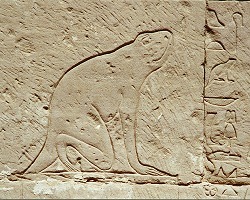
Göttin in Gestalt eines Frosches, die auch mit dem Körper einer Frau und dem Kopf eines Frosches dargestellt wurde. Sie war 'Herrin von (der bislang nicht identifizierten Stadt) Her-wer', wo auch Chnum verehrt wurde. Beide Gottheiten, die in Texten oft zusammen auftreten, wurden als Schöpfergottheiten betrachtet. Chnum war der Töpfer, der den Menschen auf seiner Töpferscheibe formte, und Heket die Lebensspenderin, die das Kind im Schoß seiner Mutter formte und bei der Geburt behilflich war. Die Vorstellung der Ägypter, die den Frosch als ein Symbol der Regeneration betrachteten, spielte hier eine Rolle, weil er zu bestimmten Zeiten des Jahres direkt aus dem Nil aufzutauchen schien. Es wurde vorgeschlagen, daß Her-wer an dem Ort gelegen habe, der später Antinooupolis nahe bei Hermupolis wurde. Ob dies zutrifft, ist noch unbekannt, aber die Göttin war tatsächlich mit den Göttern dieser Stadt verbunden. Sie war auch ein Mitglied der Achtheit und konnte als Partnerin des Thoth fungieren. Heket spielte auch in der Gruppe der Gottheiten von Abydos eine wichtige Rolle bei der Wiederbelebung des toten Osiris, gewöhnlich zusammen mit Chnum. Daher wird sie auch häufig auf Sarkophagen als Beschützerin dargestellt, eine Rolle, die sie erhielt, weil ihr Partner Chnum mit Geb identifiziert wurde und so Heket befähigte, die Rolle von Gebs Gemahlin Nut als Herrin des Sarkophages zu übernehmen. Sie ist auch auf Zaubermessern und anderen Gegenständen abgebildet, die mit dem Schutz von Geburt und Haushalt zusammenhängen. Es gibt auch Amulette in Gestalt der Heket.